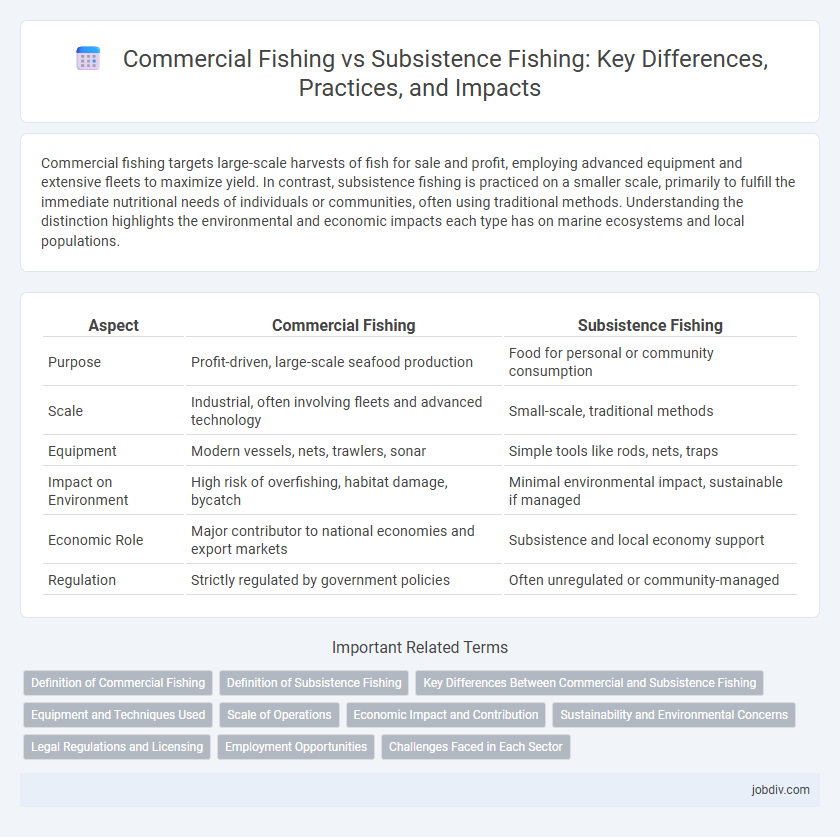Commercial fishing targets large-scale harvests of fish for sale and profit, employing advanced equipment and extensive fleets to maximize yield. In contrast, subsistence fishing is practiced on a smaller scale, primarily to fulfill the immediate nutritional needs of individuals or communities, often using traditional methods. Understanding the distinction highlights the environmental and economic impacts each type has on marine ecosystems and local populations.
Table of Comparison
| Aspect | Commercial Fishing | Subsistence Fishing |
|---|---|---|
| Purpose | Profit-driven, large-scale seafood production | Food for personal or community consumption |
| Scale | Industrial, often involving fleets and advanced technology | Small-scale, traditional methods |
| Equipment | Modern vessels, nets, trawlers, sonar | Simple tools like rods, nets, traps |
| Impact on Environment | High risk of overfishing, habitat damage, bycatch | Minimal environmental impact, sustainable if managed |
| Economic Role | Major contributor to national economies and export markets | Subsistence and local economy support |
| Regulation | Strictly regulated by government policies | Often unregulated or community-managed |
Definition of Commercial Fishing
Commercial fishing refers to the large-scale harvesting of fish and other seafood primarily for sale and profit in domestic and international markets. It involves specialized vessels, advanced equipment, and sustainable practices to maximize yield and meet economic demand. This type of fishing significantly contributes to global food supply chains and supports the livelihood of millions of people worldwide.
Definition of Subsistence Fishing
Subsistence fishing refers to the practice of catching fish primarily for personal or family consumption rather than for commercial sale or profit. It is a traditional form of fishing that supports local livelihoods and food security, often relying on small-scale techniques and sustainable resource use. Unlike commercial fishing, which operates on a large scale targeting market demands, subsistence fishing emphasizes meeting immediate nutritional needs within communities.
Key Differences Between Commercial and Subsistence Fishing
Commercial fishing targets large-scale harvests for profit using advanced equipment and vessels, supplying global seafood markets. Subsistence fishing involves small-scale, traditional methods where fishers catch primarily for personal or community consumption, ensuring local food security. The key differences lie in scale, purpose, technology, and economic impact, with commercial fishing emphasizing volume and profit, while subsistence centers on sustenance and cultural practices.
Equipment and Techniques Used
Commercial fishing relies on large-scale equipment such as trawlers, longlines, and purse seines designed for high-volume catches, utilizing advanced technologies like sonar and GPS for efficient fish detection and harvesting. Subsistence fishing employs simpler, traditional tools such as hand lines, spears, and small nets, often crafted from locally available materials, with techniques rooted in ancestral knowledge to sustain local communities. These differing approaches reflect the scale and purpose of fishing activities, impacting equipment choice and fishing methods significantly.
Scale of Operations
Commercial fishing operates on a large scale involving advanced vessels, extensive networks, and high-volume catches aimed at global markets. Subsistence fishing remains small-scale, primarily supporting local communities with basic gear and limited catch quantities for personal or family consumption. The scale of operations directly affects ecological impact, economic reach, and regulatory oversight between the two fishing methods.
Economic Impact and Contribution
Commercial fishing generates significant economic value by supporting global seafood markets, creating millions of jobs, and contributing billions in export revenues annually. In contrast, subsistence fishing primarily sustains local communities by providing essential nutrition and livelihoods with minimal market exchange. While commercial fishing drives large-scale economic growth, subsistence fishing plays a crucial role in food security and cultural preservation in coastal and rural areas.
Sustainability and Environmental Concerns
Commercial fishing often employs large-scale techniques that can lead to overfishing and habitat destruction, severely impacting marine biodiversity and ecosystem balance. Subsistence fishing typically involves smaller, community-based practices that promote sustainable harvesting, allowing fish populations to replenish naturally. Prioritizing sustainable methods in both sectors can mitigate environmental concerns while supporting livelihoods and food security.
Legal Regulations and Licensing
Commercial fishing operates under stringent legal regulations and requires extensive licensing to ensure sustainable stock management and compliance with international fishing quotas. Subsistence fishing, often regulated at the local or indigenous level, typically involves permits that allow for limited catch primarily for personal or community consumption, emphasizing cultural preservation and resource conservation. Enforcement mechanisms differ, with commercial operations subject to frequent inspections and reporting requirements, while subsistence fishing relies more on traditional governance and community-based monitoring.
Employment Opportunities
Commercial fishing generates millions of jobs worldwide, supporting industries such as processing, transportation, and equipment manufacturing, which boosts local and global economies. Subsistence fishing provides vital employment in rural and indigenous communities, sustaining livelihoods through traditional methods and local market sales. Both sectors contribute significantly to food security and economic stability, with commercial fishing driving large-scale employment and subsistence fishing ensuring community-level sustenance.
Challenges Faced in Each Sector
Commercial fishing faces challenges such as overfishing, regulatory restrictions, and high operational costs, including fuel and equipment maintenance. Subsistence fishing struggles with limited access to resources, environmental degradation, and lack of infrastructure or support for sustainable practices. Both sectors contend with climate change impacts, which disrupt fish availability and migration patterns, affecting livelihoods and food security.
Commercial Fishing vs Subsistence Fishing Infographic

 jobdiv.com
jobdiv.com